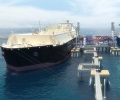
Russia’s seaborne crude oil exports rose to a seven-week high in the week to Jan. 19, according to tanker tracking data, despite a recent crackdown on Russia’s shadow tanker fleet that sparked widespread fears of reduced oil flows from the second largest exporter in the world.
Crude shipments from Russian ports averaged 3.8 million b/d in the week to Jan. 19, up 730,000 b/d, or 24%, from the second week of 2025 when export flows averaged 3.07 million b/d , according to S&P Global Commodities at Sea(opens in a new tab) data. In the same period, Russian exports of fuel and oil products slumped to 2.77 million barrels per day, down from a recent high of 2.9 million barrels per day the previous week, the data showed.
More than 80% of Russia’s seaborne crude oil exports are sold to refiners in India and China, with those countries importing about half and one-third of Russia’s maritime flows, respectively. Most of the oil is shipped using shadow fleet tankers that can operate outside Western sanctions.
The US Treasury Department announced a major expansion of its blacklisted ‘shadow fleet’ of tankers shipping Russian oil on January 10 in a move that came days after China’s Shandong Port Group banned US-approved tankers from accessing its ports in the eastern Chinese province .

Data for the week to Jan. 19 showed Russian crude oil exports to Egypt, a major storage and blending hub in the Mediterranean, averaged 418,000 barrels per day, the highest weekly level since the start of the Ukraine war. Flows to Turkey, Russia’s third-largest crude buyer, also rose sharply to 520,000 b/d in the week and 1.35 million b/d of Russian crude had unknown destinations, the data showed. Most Russian crude oil flows to unknown destinations after loading often end up in India and China.

Rough discount
Middle Eastern crude oil premiums jumped sharply after the US announcement on January 10, as Chinese and Indian refiners are expected to return to Middle Eastern crude supplies temporarily to avoid Russian flows. The shadow fleet crackdown also caused Aframax freight rates for shipments of ESPO Russian blended crude from Kozmino to North China to skyrocket from $1.625 million on the weekend ending January 10 to $6.25 million on January 16. At the same time, VLCC rates soared with oil prices from the Arabian Gulf to Japan surging from $11.37/mt on January 10 to $17.11/mt on January 1. 15, the highest level since May 2024, according to data from S&P Global Commodity Insights.
With new sanctions cutting off Russia’s access to its shadow fleet, the value of Russian crude is expected to weaken as more exports are forced to use Western shipments permitted within the G7 oil “price cap” of $60/b set in December 2022.
Russia’s ESPO crude exports from Kozmino were valued at a discount of $11.5/b to Platts Dubai on Jan. 14, Commodity Insights data showed, after widening sharply from a $1.7/b discount on Jan. 10 to the widest discount since February 2023. Discount to However , Russia’s main export product, the Urals, has not yet reacted.
Platts values the Urals discount on an FOB basis from Primorsk to Dated Brent at $11.05/b on January 17, the lowest level seen since the invasion of Ukraine and up from a post-invasion high of $40/b in April 2022.
Source: Platts




